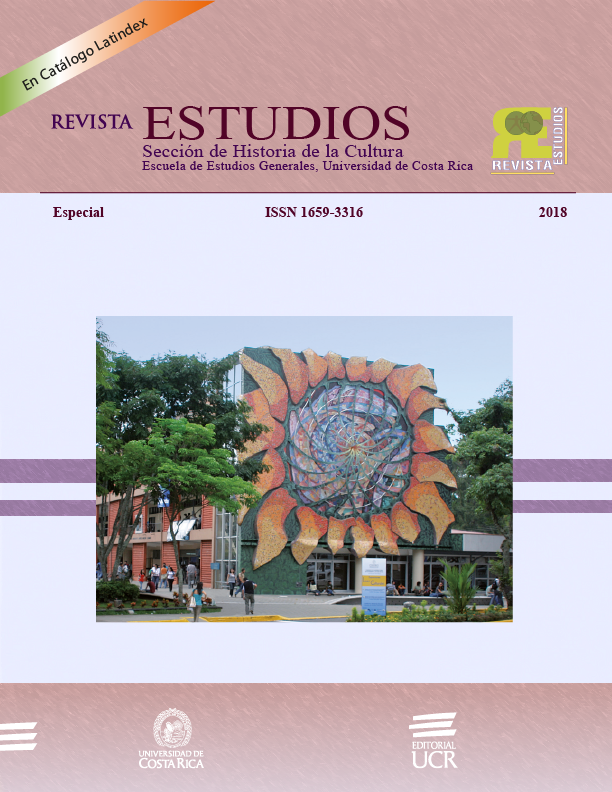Abstract
In this novel you can see the diversity of historical moments that converged in the ancient Japan of the sixteenth century, which shows a diversity of political and military movements of the great daimyo, in search of its main objective is the Japanese unification and domination of three great clans that are; Oda, Tokugawa and Toyotomi. On the other hand, the external movements of religious and military influence in the lands of the rising sun are presented and, finally, the participation of the lower classes of the Japanese social pyramid introduced in the art of war can be seen. It should be clarified that in the present novel there are fictitious characters and facts, created by the author, both the main and secondary characters, who unite with the historical facts of the time.References
Ferrer, S. Breve historia de la mujer. (Madrid: Ediciones Nowtilus, 2017). [en línea] consultado el 16 de diciembre del 2017 en: https://books.google.co.cr/books?id=YTNJDgAAQBAJ&lpg=PT157&dq=historia%20de%20la%20mujer%20en%20japon&pg=PT157#v=onepage&q=historia%20de%20la%20mujer%20en%20japon&f=false
Hernández, S. Japón. El país de la espada y la flor. España, Entre líneas editores, 2007. [En línea] revisado el 15 de octubre del 2017 en: https://books.google.co.cr/books?id=FkocaTrpDikC&lpg=PA27&ots=hfz0aHSnIv&dq=provincia%20de%20owari&pg=PA4#v=onepage&q=provincia%20de%20owari&f=false
Lázaro, M. “Japón – Cristianismo: Dos lógicas diferenciadas, un mismo ser humano, diálogos interreligiosos, en la nueva civilización del siglo XXi”. CAURIENCIA. Vol. 2 (2010) p. 93- 131. [En línea] revisado el 15 de octubre 2017 https://www.google.com/url?sa=t&rct=j&q=&esrc=s&source=web&cd=1&cad=rja&uact=8&ved=0ahUKEwintYqHgY3XAhVEQiYKHTJLDuYQFggmMAA&url=https%3A%2F%2Fdialnet.unirioja.es%2Fdescarga%2Farticulo%2F3430579.pdf&usg=AOvVaw2tQzfDH0tjYrOhiYD8Qfd4
Norton, J & Redactores Time – Life. Japón Antiguo. Amsterdam: TIME. 1968
Prats, Ramón. “Japón, el período beligerante y los tres unificadores” p. 123- 139 (2013) [En línea] revisado el 24 se septiembre del 2017 https://dialnet.unirioja.es/descarga/articulo/4462438.pdf
Reyes, A, “Introducción de las armas de fuego en Japón” Brocar. Vol. 33, (2009) p. 43-66 [En línea] revisado el 24 se septiembre del 2017 https://www.google.com/url?sa=t&rct=j&q=&esrc=s&source=web&cd=1&cad=rja&uact=8&ved=0ahUKEwi9wYXvrMHWAhXJWCYKHQRgDFoQFggmMAA&url=https%3A%2F%2Fpublicaciones.unirioja.es%2Fojs%2Findex.php%2Fbrocar%2Farticle%2Fdownload%2F1624%2F1518&usg=AFQjCNELwMuyKD38BCMePtrVAQpQm6X_cQ
Rodríguez, I. “El feudalismo, ¿Un concepto generalizable? El caso japonés” Revista Universitaria de estudios sobre Asia oriental. No. 10 (2017). P. 63-88 [En línea] revisado el 24 se septiembre del 2017 http://www.raco.cat/index.php/asiademica/article/viewFile/327377/417912
Tramon, J. El catolicismo en Japón. Testimonio del encuentro de dos culturas, Pharos, vol. 13, núm. 1, mayo-junio (2006). p. 41-57. [En línea] consultado el 15 de Octubre del 2015 en: http://www.redalyc.org/pdf/208/20813106.pdf
Witney, J. El imperio japonés. Bogotá: Siglo Veintiuno Editores, 1985.


